Everything you need to know about Microsoft HoloLens
Hang on, there's something on your face
Microsoft HoloLens tech
HoloLens is essentially a head-worn computer, controlled via voice, hand controllers and gesture recognition. It also incorporates a camera, so the computer knows what you are looking at, a screen so it can overlay graphics and text on what you're looking at, and speakers for sound.
Little actual tech spec has been revealed for HoloLens beyond that its camera will have a 120x120-degree field of view.
As with other augmented reality headsets, HoloLens includes a screen that sits a few centimetres from your eyes, tricking your brain into thinking you are really seeing the things on screen hanging in space, in the real world.
In HoloLens' case, the part of the screen on which you see the most detailed graphics (the "holograms" as Microsoft has is) is about 3 to 4 inches squared. Less detailed graphics fill your entire field of vision in some demoes we've seen, but this is the sweet spot; it's where the action is.
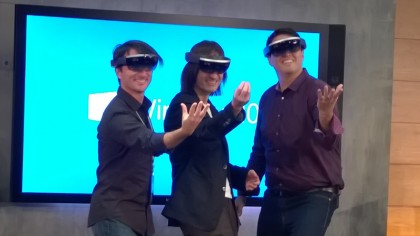
The issue that most users have reported is that, despite the camera having a theoretically adequate field of view, the screen does not. So as you move your eyes around, the graphics vanish from sight. This was our experience too and worryingly, Microsoft VP Kudo Tsunoda has suggested that this issue is unlikely to be resolved before its release to developers.
However, while users of headsets for virtual reality, the cousin of augmented reality, often report motion sickness, we did not find this to be a problem with HoloLens. This is probably because your brain is better able to cope with the "unreal" elements presented by the device, because they are overlaid on the real world. By contrast with VR, everything you see is, by definition, unreal.
While there is no information on the HoloLens' processing power, we can conjecture that mapping complex graphical and other information onto physical surfaces in real time requires a lot of oomph.
Sign up for breaking news, reviews, opinion, top tech deals, and more.
HoloLens actually employs three processors: the usual CPU and graphics chip (GPU), plus a holographic processing unit (HPU). The latter apparently handles the spatial mapping and gesture control elements of HoloLens, among other tasks.
Microsoft HoloLens design
HoloLens is like a very bulky pair of sunglasses. Its screen sits in front of your eyes while two arms extend over your ears.
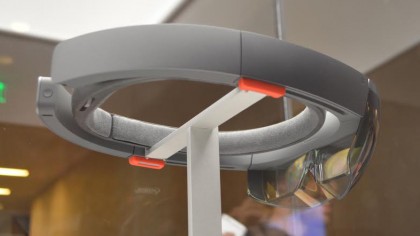
The arms include the majority of the computer and speakers, projecting sounds into the ear. Binaural effects give the experience a more realistic edge but unlike headphones, do not block out sounds. So again, HoloLens is adding to the real world rather than replacing it…
HoloLens is surprisingly comfortable, if a little bulky and, understandably, front heavy. It can be worn with glasses. It feels like there is a way to go before it fits most people perfectly, first time, but it's certainly not bad for what is, in effect, currently a prototype.
Microsoft HoloLens: apps and games
HoloLens runs Windows 10 and so, in theory, all of the apps that are available for the latest version of Windows are also available on HoloLens.
Of course, this isn't going to be the case right away but Microsoft is working to bring as many apps to HoloLens as soon as possible and opening up the unit to developers first (as opposed to, say, just giving out out) is a good place to start.
The Windows Holographic initiative, which starts with HoloLens, is all part of the Windows 10's push toward inclusivity among devices.
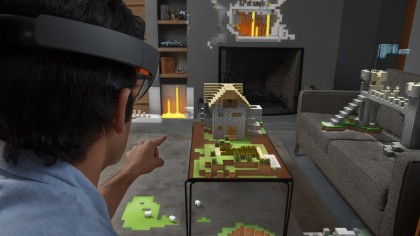
One of the most notable pieces of software that will definitely be available for HoloLens is Minecraft, the maker of which was acquired by Microsoft for around $2.5 billion (£1.6 billion) in cash. The implementation demonstrated thus far places Minecraft world's in your front room so you can look around and into your created worlds.
One thing's for sure: kids (and many adults) love Minecraft and Microsoft will likely leverage that fact like mad when finally marketing HoloLens as a consumer device – assuming Minecraft is still wildly popular by the time it comes out, of course.
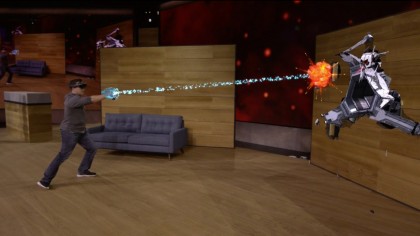
The most recent demo of HoloLens, at Microsoft's September 2015 Windows 10 event, revealed Project X-Ray. This demo involved a player in an onstage 'room' using a holographic arm cannon to blast insectoid robots who smashed through the walls of the 'room'.
HoloStudio is aimed at Microsoft's enterprise customers. Microsoft has made a big deal of all the business uses for the headset and HoloStudio, which allows 3D modelling and then printing, is perfect for this. Computer-aided design (CAD) is currently done in a 2D environment which makes no sense when the output — i.e. the product — is 3D, and HoloLens should help to solve some of these problems and, in the process, aid in making more realistic models.
One of the most obvious — and also demoed — uses for HoloLens is communication and Microsoft is rolling out a specially made Skype application for the headset. Users can share their view and have it so that the other person is right there with them, which should make long-distance couples much happier.
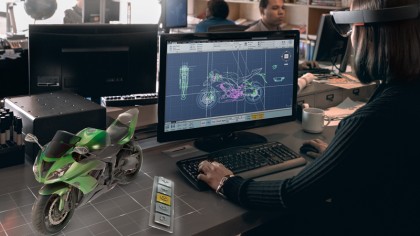
OnSight and Sidekick are applications that Microsoft is developing in partnership with NASA to help with space exploration. The company has previously demoed these features extensively, showing a man "looking" at Mars through a HoloLens headset — and it's easy to see why the agency may be interested. Going to Mars costs a lot more than $3,000.
So, is HoloLens for you?
In many ways it's really too early to answer this question except to say that if you love early stage hardware that will likely be awkward to use for the next few years then, yes, HoloLens is for you.
For everyone else, HoloLens will become better and better over time. Just as the first iPhone looks substandard now, in a decade's time, so will HoloLens v1. Whether it will be as ubiquitous as smartphones remains to be seen.
- 1
- 2
Current page: Microsoft HoloLens: everything else
Prev Page Microsoft HoloLens price and release dateMax Slater-Robins has been writing about technology for nearly a decade at various outlets, covering the rise of the technology giants, trends in enterprise and SaaS companies, and much more besides. Originally from Suffolk, he currently lives in London and likes a good night out and walks in the countryside.